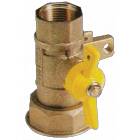The relief system in gas safety valves
In order to maintain a system fully operational, pressure variations should be minimised, which can be done via the gas safety valves

The gas management systems are designed to maximise the efficiency of the plant in normal operating conditions or when at a standstill: it is always best to work at constant operating conditions as much as possible and this can be guaranteed by components such as gas safety valves. There are two reasons in favour of the implementation of this operation method: the first is that when a machine of any kind works under normal operating conditions, consumption lowers and efficiency is maximised, thus allowing a saving on fuel. The second factor is in the design stage of the mechanical components: the strains, both mechanical and thermal, are greater in the start-up stage and consequently, before the constant temperature and pressure conditions identified as parameters of correct and normal operation are reached, the system is subjected to variable strain and this makes maintenance more costly. Gas safety valves are an effective device for managing the plant’s operating conditions.
Metals used for gas safety valves are usually brass and other alloy elements that when added to the original alloy, increase its mechanical properties, allowing the life of the component to be maximised. Therefore safety valves help avoid some of the typical problems that characterise these plants.
Metals used for gas safety valves are usually brass and other alloy elements that when added to the original alloy, increase its mechanical properties, allowing the life of the component to be maximised. Therefore safety valves help avoid some of the typical problems that characterise these plants.
01/01/2014
I contenuti di questo sito non hanno carattere di periodicità e non rappresentano 'prodotto editoriale'.








